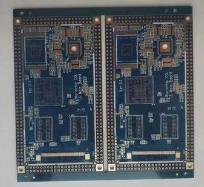1 Definition of thick copper multilayer board
Knowledge about thick copper circuit boards: copper foil (surface-treated electrolytic copper foil or rolled copper foil) with a thickness greater than or equal to 105 mm (mass per unit area of 915 g/m2 or 3 oz/ft2) is usually called thick copper foil. At present, the thick copper foil used in PCB is 105 mm, 140 mm, 171.5 mm, 205.7 mm, and sometimes 411.6 mm.
PCBA boards will inevitably generate heat during use. This heat comes from the heat of electronic components, the heat of the PCB itself, and the heat of the external environment. Among the three heat sources, the heat of the electronic components is the largest, followed by the heat of the PCB itself. The heating of components is determined by their power consumption. PCB boards carrying high-power devices are generally accompanied by high currents. Therefore, when designing high-current PCBs, first consider the production of conductive layers through large currents and the circuit board, and secondly consider the safe tolerance of PCBs. The ability to generate heat from large currents.
According to the current size of the copper conductor is proportional to the size of the cross-sectional area of its line. Therefore, the design of increasing the thickness of the copper foil or increasing the line width can be used to meet the needs of large current loads. For some high-current, high-power power supply boards, more circuits need to be designed in a limited space, so the demand for thick copper multilayer boards is increasing.

The thick copper multi-layer board is laminated with a thick copper copper clad laminate and a PP sheet, and pressed into the required multi-layer board. At present, the use of thick copper core boards for laminated inner boards has become another development trend in the PCB industry. However, due to the thick copper thickness of the inner boards, whether the resin can be filled during lamination, and whether the thickness of the entire board meets the requirements and other structural features Problem occurred.
2 Market Application of Thick Copper Multilayer Board
In recent years, the world's market demand for thick copper has increased rapidly. The development, production and sales of thick copper foil copper clad laminates and thick copper multilayer printed circuit boards have become popular in the industry. The rapid development of high-current substrates, power supply substrates, and heat dissipation have basically become the main aspects of driving the expansion of the thick copper foil CCL and thick copper multilayer board market.
At present, the main application market for thick copper foil is the manufacture of high-current substrates. High-current substrates are generally high-power or high-voltage substrates. They are mostly used in automotive electronics, communication equipment, aerospace, network energy, planar transformers, and power conversion. Devices (modulators), power modules, etc., involve fields such as automobiles, communications, aerospace, electric power, new energy (photovoltaic power generation, electric power generation), semiconductor lighting (LED), electric locomotives, etc. With the development of thinning and miniaturization of electronic products, PCBs are urgently required to have higher thermal conductivity, and the application of thin-core thick copper multilayer boards has become more extensive.
The development of thick copper PCB products has also extended a new industrial chain centered on it, and its terminal electronic product field is also different from conventional PCBs.
3 The future trend of thick copper multilayer boards
With the continuous development of electronic technology, the number of functional components integrated on the PCB is increasing, and the requirements for the current conduction capacity and carrying capacity of the circuit are getting higher and higher. High-thick copper circuit boards that provide high current, high power and integrated power will gradually become a trend in the development of the circuit board industry in the future. It is also the direction that all circuit board factories and circuit board factories need to develop and overcome more technological problems in the future.